Puffer fish are the second-largest order of vertebrates known as Tetraodontiformes. These hyper oceanic fish have large, balloon-like bodies and can inflate themselves when they are scared or threatened. When these fish puff-up, their skeletons are not covered by skin like other fish. Some pufferfish consume small fish and crustaceans while others feed on algae or scrape algae from rocks. Puffers can grow to about 36 inches in length, but most species have an average length of 18 inches.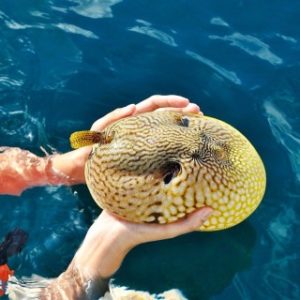
Habitat of Freshwater puffer fish
The Freshwater pufferfish is a freshwater variety that lives in Southeast Asia and lives in rivers, swamps, and ponds. Freshwater Puffers are ornate looking fish with many colors on their bodies ranging from black to blue to bright green. They have a large mouth and canine teeth which they use to eat invertebrates such as crustaceans and mollusks while using their spines in self-defense. These freshwater puffers can grow up to 50 centimeters in length. A specimen of a freshwater puffer fish known as Colomesus asellus is the largest pufferfish species. Freshwater puffers do not have poisonous spines like their cousins that live in salt water, but they are very dangerous and can inflate themselves instantly if they feel threatened.
Freshwater puffers Behavior
Freshwater puffers are commonly found in ponds and swamps in Indonesia, Myanmar, Thailand, Laos and Malaysia. The freshwater puffer can live to 30 years old with proper care. They tend to be a very peaceful fish that will do best in groups of 5 or more individuals. These pufferfish have been known to be aggressive towards other fish if they are not maintained together in a group. The freshwater puffer uses its air bladder to inflate itself like other freshwater puffers do, but it also has the ability to extend their dentaries that allow the fish to bite larger prey and protect themselves from predators.
These freshwater pufferfish can be aggressive when kept with others of its kind or when it is not in a group of at least 6. The pufferfish will normally be seen swimming along the bottom of their tank looking for small crustaceans to eat. The freshwater puffers are known to have very good appetites and will eat many freeze-dried treats, insect larvae, bloodworms and shrimp tablets as well as flakes.
Taking care of Freshwater puffer fish
Freshwater puffer fish are easy to take care of. They must be in a group, with at least 4 or more other puffers. They can do well in lower temperatures but need room temperature water that is well oxygenated and has very low levels of nitrates. They like to have hiding places such as rocks and plants in the tank and should never be put with other fish as they will attack other fish.
The pufferfish is a very peaceful by nature. It does not require much swimming space, and it can easily be kept in smaller tanks. They are generally quiet, but may have some quacking when stressed or upset.
Aquarium puffer fish
Freshwater puffer fish are natives of freshwater and inhabit the rivers, lakes and ponds. They are a monophyletic group of organisms that consist of all gill-bearing aquatic craniate animals that lack limbs with digits.
They are found on every continent except Antarctica, and inhabit a variety of aquatic environments. The family Tetraodontid has members in both freshwater and marine habitats.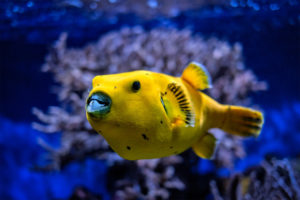
Tetraodontids have elongated bodies covered with scales which overlap like shingles. They have four or five pairs of gills, depending on the species; internal gills are never present. These fish have a well-developed caudal fin, but lack dorsal and anal fins. Some species can swim, while others crawl on the substrate; all are able to “walk” along the bottom using their pectoral fins.
The brain of pufferfish
The brain of pufferfish is small with a simple hemispheric shape. The structure of the brain suggests a relatively poor ability to process sensory information. Their eyes are very small, and lack movable eyelids; it is believed that they can only sense differences in light intensity, not images. Teeth are absent from their powerful jaws; instead, they have horny plates on their pharynx used for crushing shells and exoskeletons of crustaceans. These species are mainly bottom-feeders, feeding on mollusks, echinoderms, crustaceans, worms, sea urchins (mostly “Strongylocentrotus droebachiensis”), small fish, and algae.
The diet of pufferfish
Their diets vary among the different species of pufferfish, but consist mostly of benthic organisms such as polychaetes and crustaceans; some are detritivores.
Sometimes they swim in schools when hunting for small fish or invertebrates at the bottom of freshwater rivers or lakes. They usually eat live prey, but some species also scavenge. Puffer-fish can be separated into three distinct feeding types based on the relative length of their intestines: short-gut puffer fish, which have intestinal lengths up to 0.5 times their body length; medium-gut puffer fish, 1.0–1.5; and long-gut puffer fish, 2.0 or more. Short-gut puffer fish are bottom feeders, while the long-gut puffer is an active predator of invertebrates in open water.
Digestion in Pufferfish
The role of the liver and pancreas in digestion varies among pufferfish species. Freshwater pufferfish have a large liver but small pancreas and gill. This means that their liver plays an important role in digestion, while the pancreas has little to none.
Freshwater puffer fish are often found in rivers and ponds of India, Pakistan, Sri Lanka, China and Japan. They are found at great depths (2–30 m), though they usually occur near the shore or in shallow waters during the monsoon seasons. They are frequently found in rice fields, ponds and slow moving streams.
Stomachs of Pufferfish
Pufferfish have highly distensible stomachs that allow them to swallow prey larger than themselves. The digestive tract is extremely long, allowing pufferfish to feed on a wide variety of organisms ranging from small fish and invertebrates to seeds and detritus. Predators of Pufferfish include the freshwater pike “Esox lucius”, loach, catfish, snakeheads and an array of other predatory fish. Their eggs are also eaten by various species of birds that live nearby including herons and kingfishers.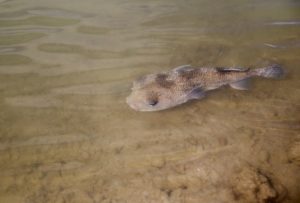
The only known natural predator of pufferfish is the cookie cutter shark, which rips circular pieces of flesh from its victims using its suctorial lips.
Freshwater puffer fish tank size
The freshwater pufferfish is a small, slow-moving fish that lacks limbs with digits. It has an elongated body covered in overlapping scales and four or five pairs of gills, depending on the species. The brain of pufferfish is small with a simple hemispheric shape.
The structure of the brain suggests a relatively poor ability to process sensory information. Teeth are absent from their powerful jaws; instead, they have horny plates on their pharynx used for crushing shells and exoskeletons of crustaceans.
Freshwater puffer fish
Freshwater puffer fish can be found in rivers and ponds across India, Pakistan, Sri Lanka, China and Japan at depths ranging from 2–30 meters deep (6–98 feet). They are found in India, Pakistan, Sri Lanka, China and Japan. They are frequently found in rice fields, ponds and slow moving streams.
Freshwater puffer fish eat lots of different foods that are mostly small animals like worms or dead bits of plants. Freshwater puffer fish have special parts on their throats to chew up bones from larger prey.
Freshwater spotted puffer fish
Spotted freshwater puffer fish are a species of freshwater pufferfish that are native to the rivers and lakes in South America. They have been seen in parts of Bolivia, Brazil and Argentina and some other parts of South America. These puffer fish can be found mostly in large rivers or lakes with rapid currents. They are mostly bottom feeders and will eat anything from crustaceans, worms, insects, snails, plant matter or other animals.
Freshwater spotted puffer fish habitat
Spotted freshwater puffer fish are nocturnal, they like to hide in sand or mud on the river bottom during the day and come out at night to look for food. They have a large mouth that allows them to eat larger pieces of food than other types of puffer fish. These puffer fish will puff themselves up when threatened by predators or if they feel like a potential mate is interested in them. When puffed up these fish can reach almost twice their normal size and are very protective of their eggs.
Freshwater spotted puffer fish
If compared to other freshwater puffer fish, spotted freshwater pufferfish have thinner bodies than other types of puffer fish. They have very large pontytail fins that help them swim and manoeuvre in the water. Their dorsal fin is also slightly shorter than other types of puffer fish, they don’t attach their eggs to plant matter like some species do. The spotted freshwater pufferfish’s body will change colour based on its mood, if it senses danger the colour of its body will turn from grey to brown or black. This puffer fish is mostly brown with a faint yellow stripe that runs across its back and they have very small spots on their body in varying shades of grey-brown colours.
Dwarf puffer Fish
Dwarf pufferfish are a freshwater pufferfish that can be found throughout the Indo-Pacific region, typically in marine or estuarine habitats. They are mostly bottom feeders and will eat anything from crustaceans, worms, insects, snails, plant matter or other animals. Dwarf pufferfish have the ability to inflate their stomachs with water or air to expand themselves and look more intimidating when threatened by predators.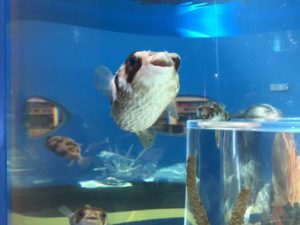
Dwarf puffer fish can be found in many different places but they are mostly seen on coral reefs and seagrass beds. These puffer fish contain tetrodotoxins which is one of the most lethal poisons known to us today, it’s also a neurotoxin and works by inhibiting sodium channels on the nerve cell membranes in our body. When this toxin is consumed it can cause paralysis and death by suffocation. These puffer fish are mostly targeted by people for food, aquariums or scientific research.
How big do puffer fish get?
The freshwater puffer fish is an omnivore, meaning whatever it can find to eat, it will. The freshwater freshwater puffer fish gets its name from the way that the fish “puffs” up when threatened or handled aggressively. “Puffing up” is done by quickly sucking in a large amount of water into its stomach. This allows the fish to increase in size and it prevents the predator from being able to swallow the puffer whole.
The freshwater puffer fish lives primarily in Indonesia, where they are quite popular with aquarists . They have also been introduced into Taiwan, the Philippines , and Thailand. They are popular not only as an aquarium fish but also as a food source for humans in some areas of Asia .
Pufferfish as a poisonous fish
All parts of the freshwater puffer fish are poisonous to humans–the meat, skin, blood and even internal organs is toxic. Despite this, many cultures still eat the freshwater puffer fish as a delicacy. The toxin found in puffer fish is called tetrodotoxin, which affects the nervous system and paralyzes muscles.
In Japan, fugu chefs are trained to prepare fugu safely so that it can be eaten. Deaths due to improperly prepared fugu are fairly rare today but still may occur if it is not prepared by someone who is trained, despite the fact that it is illegal to serve fugu in Japan unless the chef has a license.
Where do Dwarf Puffer live and what are their natural habitats?
Dwarf puffer live in mainly freshwater marshes, streams, small rivers, ponds, and lakes in India, Thailand, Borneo, and Malaysia. They also have been found in brackish waters (water with a mix of salt and freshwater) such as estuaries. The Dwarf puffer fish are not found in the ocean.
Like other exotic species, they have been introduced to areas outside their natural habitats. Dwarf puffer can survive in waters with a pH as low as 5.5, making them able to live in water made acidic by pollution from industry or runoff from human activity.
Dwarf puffers Habitat
Dwarf puffers can be found swimming alone or in schools of up to 100 fish. Dwarf puffers are considered both a freshwater fish and an omnivore. They feed on fish, insects, crabs, mollusks, and small fish. Dwarf puffers / freshwater fish are typically yellowish brown or gray-brown with a pale stripe running from head to tail. They have small dark spots on their skin. Dwarf puffers can be poisonous but not lethal . Dwarf puffers are the most common freshwater fish in captivity and are one of the most popular “pets” in Asian and western countries. Dwarf puffers have a life span of 5-10 years . Although the exact lifespan is not known, if they live in good conditions then this is what you might expect.
Pea puffer
Pea puffer are a more recent species of puffer fish, similar to the freshwater puffer fish. Pea puffer, however, are much smaller, growing only to about 10 cm long. Pea puffer live in shallow waters and their diet consists of pea mussels. They are very popular with tropical fish enthusiasts because they don’t need a large tank or an expensive filter like many other species of saltwater fish do.
Most saltwater fish need a tank that is at least 100 gallons and need an expensive protein skimmer, along with other filters to keep the water clean. Pea puffers can be kept in a 10 gallon or even a 5 gallon tank because they are smaller than most fresh-water fish and don’t produce as much waste due to their small size.
Pea puffers are also called freshwater Pea puffers, dwarf puffer fish , and baby puffer.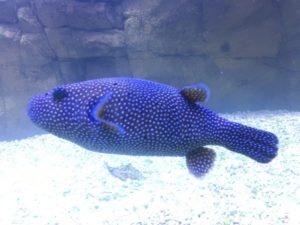
South American puffer
The south American puffer is a south American freshwater fish that belongs to the Tetraodontid family. The south American puffer ranges in length from 15-30 cm. The south American puffer has a round body and a single dorsal fin, as well as small eyes and circular nostrils. This species of south American puffers can be found in the rivers, lakes, and ponds of south America.
The south American puffer uses its sharp teeth to crush crustaceans and mollusks which are then swallowed whole. They also use these teeth to defend themselves from predators or other south American puffer fishes that might want to eat them. Males of this species are usually
Freshwater puffer fish care
Dwarf puffers are a freshwater fish that is native to the Amazon basin. They are not an aggressive species, and can be kept in tanks with other dwarf puffer or even with non-aggressive community tank mates.
Dwarf puffers live in slow moving rivers and small streams, so they prefer calm water conditions. This makes them ideal for beginner aquarists who would like to try their hand at keeping dwarf puffers but don’t have experience dealing with fast-moving currents or large amounts of turbulence.
Dwarf puffers typically grow between 2 and 3 inches long from nose tip to tail fin, making them suitable for smaller aquariums as well as larger ones since dwarf puffers do not require much swimming room. Dwarf puffers can be kept in groups of three or more, but they will only interact with their own species if the tank is big enough and lacks other fish that are competing for food.
The most important part of caring for dwarf puffer is paying attention to water quality to ensure that your beloved pets stay healthy and happy! You’ll need to do regular water changes every week with a gravel vacuum, and you’ll need to clean your filters. In addition, keep an eye out for the following problems:
Parasites – Dwarf puffers are prone to skin flukes around their eyes and mouth, which will be gray in coloration during the day but red at night. These parasites can be treated by raising water temperatures and improving the aeration of the water.
Dwarf puffers do just fine in freshwater aquariums, but they will have a more difficult time adjusting to them than saltwater tank mates will have with freshwater tank conditions. The biggest issue is that freshwater aquariums tend to not get as warm as saltwater aquariums do. Dwarf puffers come from temperatures ranging from about 77 degrees to 86 degrees Fahrenheit, and the water can be a little murkier than you would find in most home tanks.
Do puffer fish have teeth?
– Congo puffer has venomous spines in its dorsal fin which it uses to defend itself from large predators (sharks etc)…it is a defense mechanism encountered by divers who are sometimes bitten as the Congo puffers try to escape capture
The Red-Bellied puffer fish is a few species of freshwater puffers native to South America. They have a row of conical odontoids running down the outside edge of their cheeks. The Red Bellied puffer will often use these prickles to grab onto a rock or a piece of wood inside a river, where they spend a lot of time sitting still. This is a defensive strategy because a predator will often approach a puffer fish slowly and try to catch it by surprise, but a puffer fish with its mouth stuck to a rock or a piece of wood can see a predator coming long before they get close enough to swallow them!
Aquarium puffer fish
The community tank is an aquarium that can be used for community programs. The community can volunteer to help take care of the fish and see first hand how they grow. There are 5 species of freshwater puffer fish, such as the fahaka puffer, which is indigenous to Africa and Asia.
In the community tank, it is important that each individual gets a personal space so they don’t fight for food or territory. Freshwater snails, such as pond snail species (which are non-native to Africa and Asia) can be added to the tank.
The fahaka puffer is a herbivore fish so it will consume all of the food provided and may need supplemental feeding through artificial methods such as adding dried algae or shrimp pellets. These pellets are easy to purchase and use. Freshwater snails eat fish food that is left behind, algae and dead or decaying matter in the tank.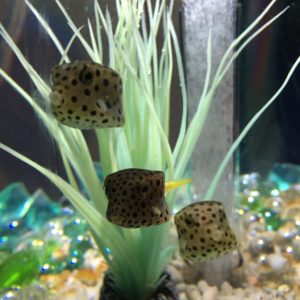
The fahaka puffer can grow to be big enough to need a 55 gallon aquarium by 10 inches long. A fahaka puffer requires a very large tank and space for it to move around. It is important to make sure they have enough space for them not to each other. There is a fahaka puffer size chart that is designed with fahaka puffer care in mind. This fahaka puffer size chart shows how big fahaka puffers can grow and what types of fish they should live with.
Do puffer fish have teeth?
Puffer fish do have teeth, but their diet that consists of meat (it’s only natural), as well as crustaceans.
“some pond snails are extremely toxic and dangerous. It is therefore not recommended for children 10 and under to have pond snails in their fish tanks.”
Puffer fish facts
Freshwater Puffer fish can grow up to 24 inches. They are also mostly oviparous, meaning they lay eggs, but some species are viviparous, meaning they give live birth.
These fish have a thick layer of mucus and a shell-like skin that protects them from enemies and predators. A puffer fish’s stomach is so strong that it can eat prey as large as its body. The puffer fish can also puff itself up by swallowing more water. The use of the word “puffer” as a noun to describe these fish is derived from their ability to puff out their body size and turn into a spiky ball. Puffing increases its size many times, making it look like a large round ball of spikes that can scare off potential predators and also scare away prey. A puffer fish can inflate itself up to 5 times its normal size
Are Puffers are carnivorous?
Puffers are carnivorous (meat-eating) fish, their diet consists of live, fresh meaty foods such as shrimps and small fishes, if it finds a smaller fish in the pond it will try to eat it. They are usually peaceful, but territorial animals and will fight with other puffers of the same species. The larger one always wins because of its large powerful teeth.
Puffers have a thick layer of mucus over their entire body which protects them from injuries during fights for dominance in pond as well as against predators (birds, pond crocs). Pond snails are non-native to Africa and Asia. They can produce many pond snail eggs and they usually lay the pond snails eggs in the plants like hydrilla or at the pond bottom.
Male Pond snails
Male pond snails have some organs called cephalic prongs that protrude above their head; this is to help them find a mate in the pond.
Males are sometimes called “piranhas of the snail world” because they can slice open their prey with their sharp swords (tongues).
Female pond snail
The female pond snails lay many eggs, about 30-50 per clutch. She makes big clumps of eggs with her body and then pushes them on a leaf. They start hatching in about 2 weeks. When the pond snail eggs hatch, they are very small with just one pair of tentacles and they look like jellyfish. The pond snail baby is very fragile and it feeds on dead plants until they grow bigger.
Green spotted puffers
Green spotted puffers are aquarium fish that can be found in freshwater aquariums. They grow to an adult size of about 3 inches and have a lifespan of up to 10 years if cared for properly. These fish eat live foods, like brine shrimp or bloodworms, as well as plant matter like cucumber slices.
Green spotted puffers should only be kept in aquariums with sand substrate because they enjoy digging around for food. If you want them to breed, it’s best to keep at least 2 males and 1 female together in the same aquarium-though sometimes they will still breed even without any other green spotted puffers around!
Green Spotted Puffers: A Brief Introduction
Green spotted puffers are aquarium fish that can be found in freshwater aquariums. They grow to an adult size of about 3 inches and have a lifespan of up to 10 years if cared for properly. These fish eat live foods, like brine shrimp or bloodworms, as well as plant matter like cucumber slices.
Green spotted puffers should only be kept in aquariums with sand substrate because they enjoy digging around for food. If you want them to breed, it’s best to keep at least 2 males and 1 female together in the same aquarium-though sometimes they will still breed even without any other green spotted puffers around!
Green Spotted Alleged Puffer Fish
The Green spotted puffer fish is one of those aquarium fish that can be kept in aquariums at home but you have to know how much space is required for this aquarium fish. Green spotted puffer fish is not suitable aquarium fish for those who are new to buying aquarium fish as they require proper care and environment that is hard to provide at home.
Knowing what kind of aquarium that will fit your green spotted puffer fish aquarium fish is the first step in keeping aquarium fish so that it will not be harmed or harm you.
Green spotted puffer Fish Diet
As said earlier, green spotted puffer fish are carnivorous aquarium fishes and will eat anything they can find in the aquarium.
They will mostly feed on freshwater aquariums’ plant life because it is easier to get than foods meant for aquarium fish. It is important that you clean aquarium regularly so that aquarium fishes will have enough space to rest. You can feed your aquarium fishes with green spotted puffer fish flakes or pellet food but do not give too much of these kinds of food; it might harm your aquarium fish as well.

